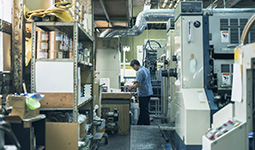March 2020
Expanding the Potential of Design with Paper

Highly artistic paper-made products from Tachikawa, Tokyo, are winning admirers in Japan and abroad.

Gently lifting the edge of the round piece of paper, with its numerous cuts in concentric circles, reveals a paper vessel. It’s full of air, light enough to give a sense of weightlessness, and the shape is easily changed into a plate or a flower vase depending on how the paper is spread out, yet it firmly keeps its shape.
Called airvase, this strange and beautiful paper vessel is manufactured and sold by Fukunaga Print Co., a company located in Tachikawa City, Tokyo. CEO Yamada Akiyoshi says, “About ten years have passed since we began selling airvase, and it has become a long-selling product, with new versions released nearly every year. Collaborating with graphic designers and many other artists, we have continued to create airvases, each unique yet made from the same 20 centimeter round shape.”
The company, a small enterprise of forty-one employees, systematically handles everything from paper printing to processing. Community-based since its establishment in 1963, the company typically printed postcards and business cards, manufactured folding boxes for local confectionery shops, and so on. However, in 2006, when Yamada took on the role of second CEO, the company started on the Kami No Kousakujo (paper workshop) project to pursue the potential of paper internally. Yamada explains, “We are facing a difficult time as small printing companies in town are gradually being eliminated through the digitalization of printing and the movement towards becoming paperless, but Japan produces many types of paper unknown to the world, and each has beauty as a material. I wanted to show the world the artistic qualities of paper.”


Graphic and product designers participate in the Kami No Kousakujo project, suggesting new paper products with unrestricted ideas and forming those ideas into products together with Fukunaga Print Co.’s engineers.
From these ideas, the unique 1/100 Architectural Model Accessories Series was born, producing incidental scenes entirely with paper, using the people, plants and so on used in architectural models. This is a product of architect Terada Naoki. First exhibited in 2009 at Interior Lifestyle, an international trade fair held in Tokyo, the products that were created out of the Kami No Kousakujo project drew a large amount of attention from visitors and increased the number of inquiries from abroad.
airvase was designed by Torafu Architects, a group of Tokyo-based architects, in 2010. The idea required great technical ability for the die-cutting processing, which uses a blade pattern with a fine pitch to precisely cut out shapes, but the Fukunaga Print Co. team of engineers managed to make this work and the product was commercialized.
In 2011, Fukunaga Print Co. and Terada created the new TERADA MOKEI brand, selling products that allow users to enjoy three-dimensional designs by simply cutting or folding paper, such as the 1/100 Architectural Model Accessories Series, the 1/100 Architectural Model Greeting Card, and the 1/100 Architectural Model Accessories Series Coaster.
Currently, thirty-five groups of designers participate in the Kami No Kousakujo project, creating a wide variety of products, such as notebooks, message cards, games and photo albums. Other examples include origami paper and puzzles that use geometrical patterns created by Tokoro Asao, who also designed the emblem for the Olympics and Paralympics to be held in Tokyo in 2020, and a mobile designed by architect and designer Nagaoka Ben that mimics a jellyfish drifting in the sea.
The project makes collaboration with people in a variety of fields and corporations a reality, including fashion designers, engineering designers, photographers, manga artists and fabric dyers. The project is expanding into the realm of creating large objects, such as window displays and stage design, experiential installations that fuse the latest digital art with simple paper.

Yamada says, “I feel that the potential for design is expanding through the activities of the Kami No Kousakujo project, which was started to expand the possibilities of paper. I believe that design is the power to imagine a wonderful future. Though we are in the manufacturing industry, I hope to continue to hold on to this power in the future.”

